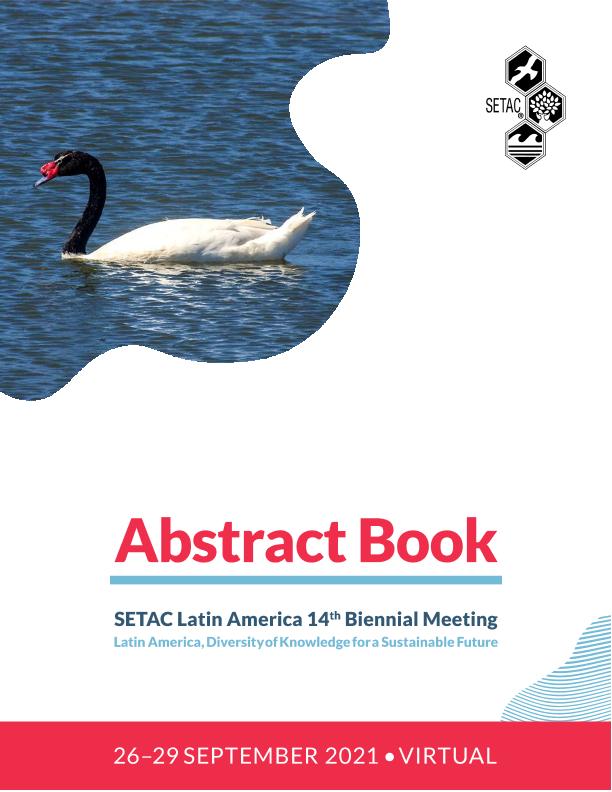Evento
A chemo-metric approach to assess heavy metal pollution status in a human impacted coastal system
Truchet, Daniela María ; Negro, Carlos Leandro
; Negro, Carlos Leandro ; Buzzi, Natalia Sol
; Buzzi, Natalia Sol ; Mora, M. Celeste; Ardusso, Maialen Gisel
; Mora, M. Celeste; Ardusso, Maialen Gisel ; Villagran, Diana Mariel
; Villagran, Diana Mariel ; Garcia, Fabian Ezequiel
; Garcia, Fabian Ezequiel ; Marcovecchio, Jorge Eduardo
; Marcovecchio, Jorge Eduardo
 ; Negro, Carlos Leandro
; Negro, Carlos Leandro ; Buzzi, Natalia Sol
; Buzzi, Natalia Sol ; Mora, M. Celeste; Ardusso, Maialen Gisel
; Mora, M. Celeste; Ardusso, Maialen Gisel ; Villagran, Diana Mariel
; Villagran, Diana Mariel ; Garcia, Fabian Ezequiel
; Garcia, Fabian Ezequiel ; Marcovecchio, Jorge Eduardo
; Marcovecchio, Jorge Eduardo
Tipo del evento:
Congreso
Nombre del evento:
SETAC Latin America 2021 14th Biennial Meeting
Fecha del evento:
26/09/2021
Institución Organizadora:
Society of Environmental Toxicology and Chemistry;
Título del Libro:
SETAC Latin America 2021 14th Biennial Meeting
Editorial:
SETAC Latin America
Idioma:
Inglés
Clasificación temática:
Resumen
Estuaries are among the most threatened coastal environments since they receive several pollutants from riverine discharges, large urban settlements, industries and ports. These human pressures are enhanced in developing countries of South America, such as Argentina, where the biota is at risk due to several pollutants (metals, POPs and microplastics), and therefore, biomonitoring of these areas is highly recommended. However, few studies have achieved this concern and the scientific tools displayed in an integrative way where abiotic and biotic matrices are combined using multiple indices were even less studied. The current study compared metal concentrations (Cd, Cu, Pb, Zn, Mn, Ni, Cr, Fe) in sediments and a resident benthic crab species, Neohelice granulata and the biochemical biomarkers (CAT, GST, H2O2, MT) in this organisms in a salt marsh (SM) and a mudflat (M) in different stations (autumn and spring) of a SW Atlantic estuary (Bahía Blanca estuary, BBE) in Argentina. This area is currently influenced by several industrial and domestic discharges, ports and large scale fisheries. Overall, metals in sediments did not exhibit significant differences between sites and seasons, except for Mn higher in SM during spring. Crabs bioaccumulated more Cu from sediments during autumn than spring for both sites. Except for Cd in M, Mn, Ni and Fe in SM, metals did not exhibit significant differences for sites, but the values tended to increase in autumn. Through geochemical indices, sediments were low to medium polluted with probable adverse biological effects to the biota. Some of the biochemical analyses applied (i.e., IBR) demonstrated high values in the SM during spring with a great contribution of H2O2 and GST. By multivariate analyses (Pearson correlations and PCA), it was possible to observe that the biomarkers induction might be due to natural intrinsic factors such as energetic costs for reproduction and not strictly metallic pollution. But also, it should be considered that during spring, the available organic matter in the estuary is higher and uptakes metals in the SM coming from plants, ultimately incorporated into the body burden of organisms and probably causing biomarkers induction by some correlated metals like Zn, Cu, Mn and Cd.
Palabras clave:
ESTUARIES
,
METALS
,
BENTHIC SPECIES
,
BIOMARKERS
,
GEOCHEMICAL INDICES
,
SEASONALITY
Archivos asociados
Licencia
Identificadores
Colecciones
Eventos(IADO)
Eventos de INST.ARG.DE OCEANOGRAFIA (I)
Eventos de INST.ARG.DE OCEANOGRAFIA (I)
Citación
A chemo-metric approach to assess heavy metal pollution status in a human impacted coastal system; SETAC Latin America 2021 14th Biennial Meeting; Pensacola; Estados Unidos; 2021; 81-82
Compartir



